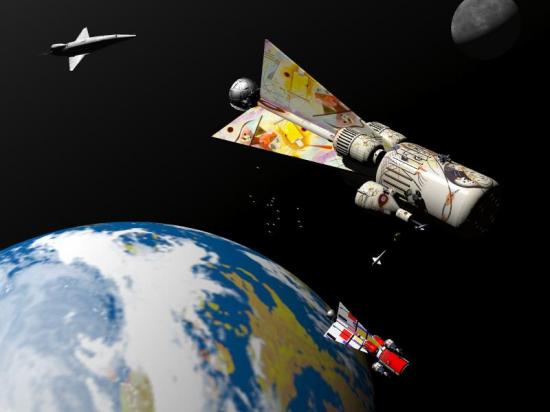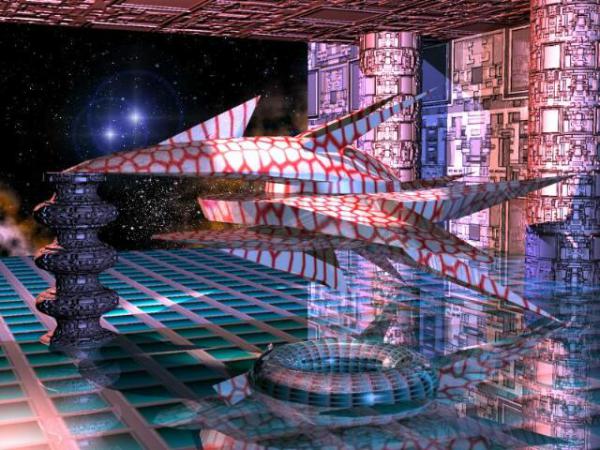BY LETTER
Ship Style and Decoration
Technology > Application > Transportation > Interplanetary Transport
Technology > Application > Transportation > Interstellar Transport
Technology > Application > Transportation > Ships
Technology > Application > Transportation > Interstellar Transport
Technology > Application > Transportation > Ships
 Image from Anders Sandberg | |
| The Wassily Kandinsky and the Piet Mondrian during boarding in Cytherea orbit, First Federation period. | |
Aesthetic Design
Among the different interstellar empires and colonies, ship design varies widely. Each culture has its own ship designs, with basic style elements due to the culture. Emple-dokcetic ships are probably modular agglomerates, Backgrounder ships stealthed black angular mini-habitats, Cygexpa ships are built according to a few corporate standards that are rarely revised and so on. These elements are due to the culture and species, a cyborg ship can handle extreme accelerations, Genetekker ships tend towards either organic technology or having liberal biospheres, vec ships may be open to space and so on, and then they can be varied. Some ships are covered with decorations, others strictly utilitarian, some are personalised, others standardized to the point of being indistinguishable.Solar Dominion ships are quite diverse in appearance (there are many cultures within the Empire), but always have a notable golden octahedron near the center, containing the prayer-chamber but also acts as an allegiance symbol. The Solar Dominion cyborgs from Faraday 19 (feared as the most zealous warrior-diplomats of known space, having refined gunboat diplomacy to a fine art) have diplomatic ships with extremely pronounced drive systems surrounding the central prayer-chamber and a bristling weapons array, more functional than aesthetic but with a strong sense of symmetry. On the other hand the cultural exchange ships of the Cotton Cluster are extremely open and vulnerable microworlds like the ancient O'Neill habitats, but equipped with drives and with the octahedron visible through the windows.
Meanwhile, there are 45 allowed classes of ships within the Negentropy Alliance empire, with sizes and structure regulated by ancient and holy rules...
Decoration Styles
It is common for ships to be customised in various ways. Many independent operators daubed slogans on the hull, and in during the middle First Federation period there was a strong tendency to artistic decoration (above). Holographic displays and other customised add-ons were also common at this time.In any case, ship decoration varies widely. NoCoZo ships tend to use large advertisements. Metasoft ships also used huge logos (this tendency, very prominent in the past, tends to be played down currently). Among some arms corporations during the First Federation era advertising tended towards the ridiculous. During the so called Colonies Squirmishes around Zeta 1 Reticuli II missiles from Atlantis vessels used advertising spiels for their targets - "Wouldn't you want a Trillicon Arms Antimissile Shield now?", although the commercial effectiveness was obviously somewhat limited.
Religious symbols are often used on Ships of the Sophic Alliance, part of the Sophic League, beautiful and expensive plasma sheet ornaments on exotic ships from some of the Outer Volume colonies. Not to mention the eccentrics of each civilisation who add their own touches, especially the relativist eccentrics.
The independent shipbuilders of the Cythera system have long painted their ships in bright designs, often replicating famous paintings, stylistic mannerisms or other iconic images. Particularly admired are ships painted in ancient Earth styles, from Old Stone Age cave paintings to Jyylis Hern's minimalism.
Although it is sometimes stated that the dour Negentropists insist ships always have to be a uniform adamant grey, this is strictly speaking not correct. Adamant grey is color #4. Ships of the main Negentropy Alliance worlds may also be coloured cement gray, sky gray, dark gray and silver gray, depending on their office and function. While the less strongly aligned Alliance worlds may decorate their ships as brightly as those of any other empire.
  Images from Steve Bowers | |
| The carriers of the Terragen Federation use more colourful pigments on their hulls than those belonging to the Negentropy Alliance; all Negentropy ships are required to use particular shades of grey | |
Augmented Reality Decorations
Because many spacecraft remain distant from one another, often travel too rapidly for detailed viewing by eye, and are generally only visible by telescope or, more likely, a user interface such as a flight plan map or screen-window, many spacecraft and orbitals use augmented reality (AR) overlays to represent or enhance their appearance to most sophonts who view them.These overlays are usually integrated into the perception filters of most DNIs in the regions they travel through, shared through publicly available metadata. Ships and orbitals may use these AR decorations in addition to any fully virtual avatars they might use in cyberspace. Common iconography includes flames and solar flare phenomena spreading out from the radiators of the ship, mandalas spreading around the drive cone, bird wings, calligraphic representations of their written names, and rotating "holographic" signage.
Not all AR overlays are primarily visual, however. The S1 ship "Vector of the Bioluminescent Startide", for example, has chosen to represent emself with auditory sampling or symbolic representations of the sounds from the 7785 AT Laoatiaxian epic opera "Nuvjuptari Rising", even on entirely visual interfaces.
Other sophont ships often use overlays to publicly express emotions through emojis, like the Negentropist battleship Sorry I Vaporized your Orbital who reached local infamy for presenting in AR as a 50 km swarm of angry-faced, patriotically chanting dolphins while docking in every friendly system during the Version War.
Many sophont ships aligned with the Solar Dominion have frequently used extensive interactive sun-themed mandalas, while many ships of the Utopia sphere during the 9800s AT favored fractal cloud shapes. Sophonts who use AR interfaces to alter their perception and watch their skies for approaching ships will often be greeted by a slowly growing glyph or mandala icon surrounding the bright drive cone during deceleration maneuvers, especially when they are able to zoom in. Ships often send their avatar icon information in a variety of formats as they approach a system, as part of their initial hailing procedures.
Related Articles
Appears in Topics
Development Notes
Text by M. Alan Kazlev and Anders Sandberg; additions by Steve Bowers
Initially published on 20 March 2001.
Augmented Reality Decorations section by Worldtree added June, 2023.
Initially published on 20 March 2001.
Augmented Reality Decorations section by Worldtree added June, 2023.







